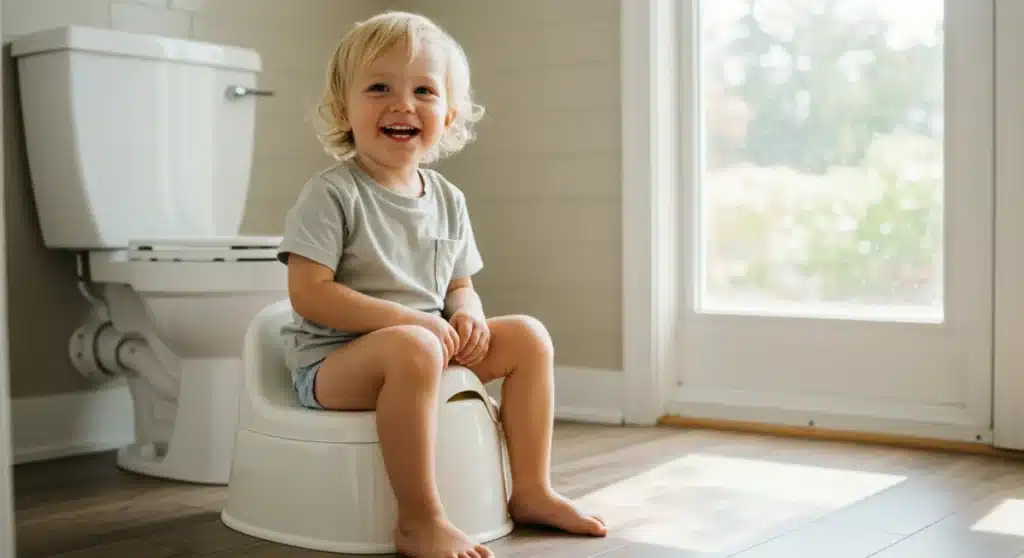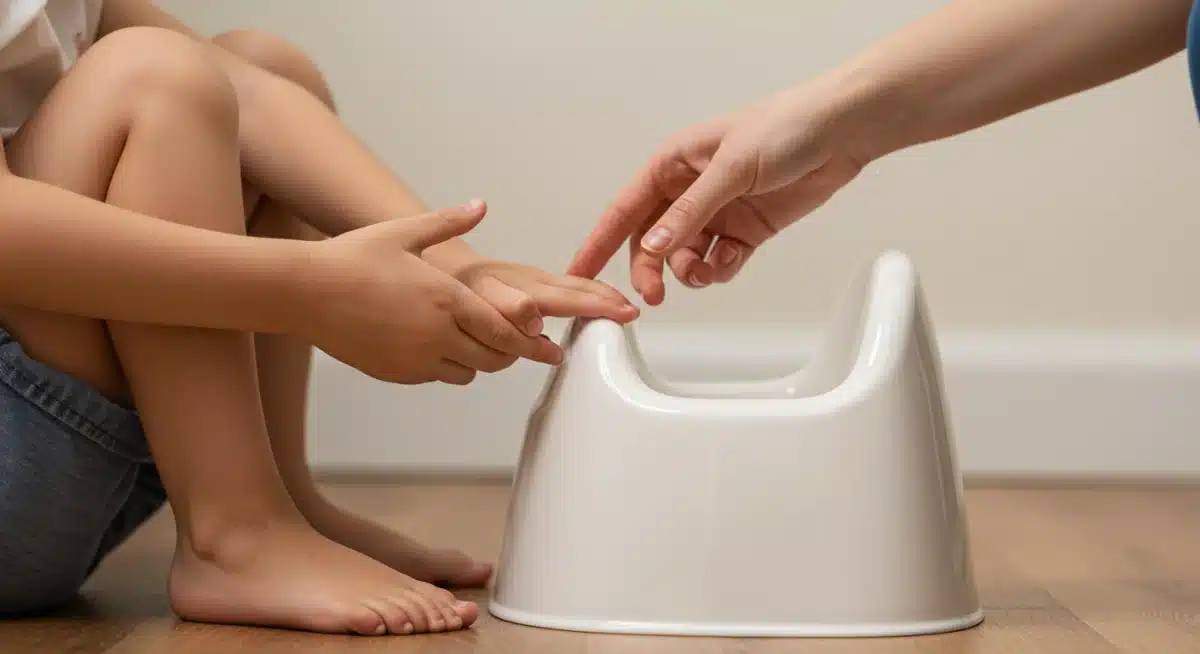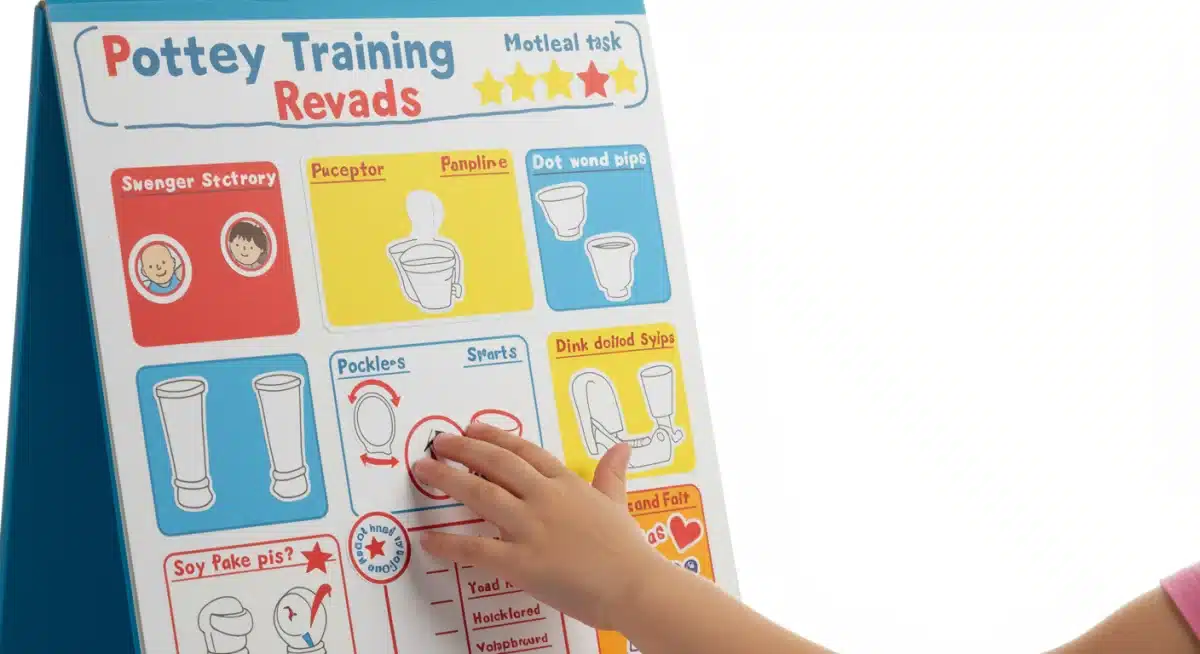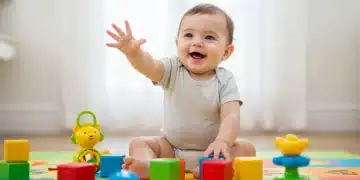Potty Training Readiness: Signs & Start Guide 2025

Advertisement
Understanding potty training readiness is key for a smooth transition, as it hinges on recognizing physical, cognitive, and emotional cues from your child to initiate effective training strategies in 2025.
Embarking on the journey of potty training readiness is a significant milestone for both children and parents. It’s a phase filled with anticipation, a bit of apprehension, and many questions about when and how to begin. This guide aims to demystify the process, offering clear signs of readiness and practical strategies to ensure a positive and successful experience for your family in 2025.
Understanding the Basics of Potty Training Readiness
Potty training is not a race, but rather a developmental journey unique to each child. For many parents, the pressure to start can feel overwhelming, especially when comparing their child’s progress to others. However, focusing on your child’s individual cues is far more important than adhering to a strict timeline.
Advertisement
The concept of potty training readiness encompasses a range of physical, cognitive, and emotional indicators that collectively signal your child is prepared to learn this new skill. Pushing a child before they are truly ready can lead to frustration for everyone involved and may even prolong the process. It’s about observing, understanding, and responding to your child’s unique developmental pace.
Physical Readiness Cues
Physical readiness is often the first set of signs parents notice. These cues relate to your child’s body control and awareness, indicating they are capable of holding and releasing their bladder and bowels intentionally. Observing these signs carefully can provide a solid foundation for beginning the training process.
- Dry for Longer Periods: Your child stays dry for at least two hours during the day or wakes up dry from naps. This indicates their bladder muscles are maturing.
- Predictable Bowel Movements: They have regular, soft bowel movements that occur at predictable times, making it easier to anticipate and plan for potty breaks.
- Fine Motor Skills: Your child can pull down their pants and pull them back up independently. This physical autonomy is crucial for self-sufficiency in the bathroom.
- Awareness of Bodily Functions: They show awareness of needing to go by squirming, grunting, or telling you after they have gone. This connection between sensation and action is a big step.
Recognizing these physical milestones is the initial step in assessing potty training readiness. They suggest that your child’s body is physically capable of managing the process, laying the groundwork for the cognitive and emotional aspects of learning.
Advertisement
Cognitive and Emotional Indicators for Potty Training
Beyond physical signs, a child’s cognitive and emotional development plays a crucial role in successful potty training. These indicators reflect their ability to understand instructions, communicate their needs, and engage in the learning process. Without these, even a physically ready child might struggle.
Emotional readiness is about your child’s willingness to participate and their ability to cope with new routines. It’s important that they feel a sense of control and accomplishment, rather than pressure or shame. This holistic view of development is central to effective potty training readiness.
Understanding Instructions and Communication
A child ready for potty training can follow simple instructions and communicate their needs effectively. This doesn’t mean they need to be fluent conversationalists, but they should be able to convey when they need to use the potty or understand what you are asking of them.
- Following Simple Directions: Your child can understand and follow one- or two-step commands, such as “Go get your toy” or “Put the book away.”
- Verbalizing Needs: They can use words or gestures to express that they need to go to the bathroom, or that they have already gone. This communication is vital for you to assist them in time.
- Showing Interest: They express curiosity about the toilet, ask questions about it, or want to watch you or other family members use it. This natural interest is a powerful motivator.
These cognitive and communicative abilities demonstrate that your child can engage with the learning process. They are not just reacting physically, but also mentally processing the steps involved in using the potty, which is a significant component of their overall potty training readiness.
Setting the Stage for Successful Potty Training in 2025
Once you’ve identified several signs of potty training readiness, the next step is to create an environment that supports successful learning. This involves preparing both the physical space and the emotional atmosphere, making the transition as smooth and positive as possible for your child. A well-prepared environment reduces anxiety and increases the likelihood of success.
Consider the practical aspects, such as choosing the right equipment, as well as the psychological elements, like fostering a positive attitude. This comprehensive approach ensures that all pieces are in place for your child’s journey towards independence.
Choosing the Right Equipment
The right tools can make a big difference in how comfortable and confident your child feels about using the potty. There are various options available, and what works best often depends on your child’s preferences and your bathroom setup.
- Potty Chair: A stand-alone potty chair is often a good starting point. It’s child-sized, easy to get on and off, and can be placed in various locations. Look for one that is stable and comfortable.
- Potty Seat Adapter: This fits on top of a regular toilet seat, reducing the opening and making it more secure for a child. Some children prefer this as it mimics an adult toilet.
- Step Stool: Essential for both potty chairs and toilet seat adapters, a step stool allows your child to reach the toilet independently and provides stability for their feet, which is crucial for pushing during bowel movements.
In addition to these, consider comfortable underwear designed for toddlers. While diapers offer convenience, switching to underwear can be a powerful signal to your child that they are now a “big kid” and it’s time to use the potty. This change can significantly enhance their sense of potty training readiness.

Effective Strategies for Starting Potty Training
With the stage set and your child showing clear signs of potty training readiness, it’s time to implement effective strategies. Consistency, patience, and positive reinforcement are the pillars of successful potty training. Remember that every child learns at their own pace, and setbacks are a normal part of the process.
Starting potty training doesn’t have to be a daunting task. By breaking it down into manageable steps and maintaining a supportive approach, you can guide your child through this transition with confidence. The goal is to make it a positive and empowering experience for them.
Establishing a Routine and Positive Reinforcement
Routines provide predictability and comfort for young children, making new experiences less intimidating. Integrating potty time into your daily schedule can help your child anticipate and prepare for it. Positive reinforcement, rather than punishment, is key to encouraging desired behaviors.
- Scheduled Potty Breaks: Offer regular opportunities to use the potty, such as first thing in the morning, before and after naps, before leaving the house, and before bedtime.
- Positive Language: Use encouraging words and praise for any effort, even if it doesn’t result in success. Phrases like “Good job trying!” or “You sat on the potty like a big kid!” are very effective.
- Small Rewards: Consider a simple reward system, such as stickers, a small treat, or extra playtime, for successful potty use. These should be immediate and consistent.
- Demonstrate and Explain: Let your child watch you use the toilet and explain what you are doing in simple terms. Children learn a great deal through observation and imitation.
Consistency in your approach and positive reinforcement for every step, no matter how small, will build your child’s confidence and motivation. This gentle encouragement is far more effective than pressure or criticism, solidifying their understanding of potty training readiness and execution.
Addressing Challenges and Setbacks in Potty Training
Even with the best preparation and strategies, challenges and setbacks are almost inevitable during potty training. It’s crucial for parents to approach these moments with understanding and patience, recognizing them as normal parts of the learning curve. How you respond can significantly impact your child’s progress and attitude towards potty training.
Understanding common issues and having a plan for how to address them can reduce parental stress and keep the training process on track. Remember, a setback is not a failure, but an opportunity to reassess and adjust your approach, reinforcing the importance of patience in cultivating potty training readiness.
Common Potty Training Hurdles
Children might experience various difficulties, from accidents to resistance, which can test a parent’s resolve. Identifying the root cause of these issues can help you find appropriate solutions.
- Accidents: These are very common and should be met with calm reassurance, not anger. Simply clean it up, change your child, and remind them gently about the potty.
- Resistance or Refusal: If your child strongly resists using the potty, it might be a sign they aren’t fully ready, or they could be feeling pressure. Consider taking a break for a few weeks and then trying again.
- Fear of the Toilet: Some children are afraid of the flush, the sound, or the feeling of falling in. A potty chair on the floor can help, as can involving them in flushing a toy down the toilet to demystify it.
- Bowel Movement Challenges: Holding in bowel movements due to fear or discomfort is common. Ensure your child’s diet includes plenty of fiber and water to prevent constipation, and make sure they feel secure on the potty.
It’s important to keep the lines of communication open with your child during these challenging times. Ask them how they feel, listen to their concerns, and adjust your approach accordingly. A supportive and empathetic response is vital for navigating the bumps in the road of potty training readiness.
Maintaining Consistency and Celebrating Milestones
The journey of potty training extends beyond the initial learning phase. Maintaining consistency in your approach and celebrating every milestone, big or small, are essential for long-term success. This continuous support helps solidify your child’s new habits and reinforces their confidence in their abilities. It’s about building a positive association with using the potty, making it a natural part of their daily routine.
As your child gains more independence, your role shifts from direct instruction to gentle encouragement and reinforcement. This sustained effort is crucial for embedding the principles of potty training readiness into their daily life, ensuring they feel secure and capable.
Transitioning to Independent Potty Use
Once your child is consistently using the potty, the focus shifts to fostering complete independence. This includes moving from a potty chair to a toilet seat adapter, managing their clothing, and eventually, handling public restrooms.
- Gradual Independence: Encourage your child to take more responsibility, such as pulling down their own pants, wiping (with your supervision initially), and flushing.
- Public Restrooms: Introduce public restrooms gradually. Explain what to expect and use a portable potty seat if your child is uncomfortable with the larger seats.
- Nighttime Training: Nighttime dryness often comes later than daytime dryness. Continue using pull-ups at night until your child consistently wakes up dry for several weeks. Accidents at night are normal and can continue for some time.
- Celebrating Progress: Continue to offer praise and positive reinforcement for consistent potty use. Acknowledge their growing independence and self-sufficiency.
Celebrating these milestones, from the first successful pee in the potty to a week of dry nights, reinforces your child’s achievements and motivates them to continue. This ongoing positive feedback is instrumental in ensuring that their potty training readiness translates into lasting independence and confidence.

The Role of Patience and Positive Reinforcement in 2025
In 2025, the principles of patience and positive reinforcement remain paramount in the journey of potty training. While new tools and understanding of child development continue to evolve, the core human need for support and encouragement during learning stages stays the same. Potty training is not merely a physical skill; it’s a significant developmental leap that requires emotional resilience from both the child and the parent.
The success of potty training readiness is deeply intertwined with the emotional climate in which it occurs. A calm, understanding, and encouraging approach fosters confidence and cooperation, turning a potentially stressful experience into a positive bonding opportunity. This holistic view ensures that your child feels secure and supported throughout the entire process.
Building a Supportive Environment
Creating an environment where your child feels safe to try, and even to fail, is crucial. This means minimizing pressure and maximizing opportunities for success. A supportive environment acknowledges the child’s efforts, not just the outcomes, which is vital for sustained progress.
- Avoid Punishment: Never punish or shame your child for accidents. This can create anxiety and resistance, making the training process much harder and longer.
- Empowerment Through Choice: Offer choices where appropriate, such as which potty chair to use or what book to read while on the potty. This gives them a sense of control.
- Consistency from All Caregivers: Ensure that anyone else caring for your child (grandparents, daycare providers) is aware of and follows your potty training approach. Consistency is key.
- Celebrate Small Wins: Every step forward, no matter how tiny, deserves recognition. A simple high-five, a cheer, or a sticker can go a long way in boosting morale and reinforcing positive behavior.
By focusing on these supportive practices, parents can help their children navigate the challenges of potty training with greater ease and confidence. This approach not only facilitates the acquisition of a new skill but also strengthens the parent-child bond, making the experience of potty training readiness a positive memory for everyone involved.
| Key Aspect | Brief Description |
|---|---|
| Physical Readiness | Child stays dry for extended periods, has predictable bowel movements, and can manage clothing. |
| Cognitive & Emotional Cues | Can follow instructions, communicate needs, and shows interest in using the toilet. |
| Starting Strategies | Establish routines, use positive reinforcement, and choose appropriate potty equipment. |
| Addressing Challenges | Approach accidents and resistance with patience and avoid punishment; seek root causes. |
Frequently Asked Questions About Potty Training Readiness
There isn’t a single ideal age; readiness varies greatly among children. Most children show signs of readiness between 18 months and 3 years old. Focusing on their individual physical, cognitive, and emotional cues, rather than their chronological age, is the most effective approach to determine when to begin.
The duration of potty training can range from a few weeks to several months, and sometimes even longer for nighttime dryness. It’s a gradual process, and consistency is more important than speed. Patience and a positive attitude from parents significantly contribute to a smoother and ultimately successful outcome for the child.
Frequent accidents are a normal part of potty training. Respond calmly, clean up without fuss, and gently remind your child to use the potty next time. Avoid showing frustration or anger. If accidents persist or increase, consider if your child might not be fully ready or if there’s an underlying issue, and don’t hesitate to take a break.
Yes, small, immediate rewards can be very effective as positive reinforcement. Stickers, a tiny treat, or extra playtime can motivate children. The key is consistency and ensuring the reward is given for effort and success. Gradually, as the habit forms, you can phase out the external rewards.
You should consult a pediatrician if your child shows signs of readiness but struggles significantly, if they were previously trained but are now regressing consistently, or if you have concerns about physical issues like frequent urinary tract infections, constipation, or pain during urination or bowel movements. They can offer guidance and rule out medical causes.
Conclusion
Navigating potty training readiness is a unique and personal journey for every child and family. By focusing on your child’s individual physical, cognitive, and emotional cues, rather than external pressures or strict timelines, you can create a supportive and positive learning experience. The key lies in patience, consistency, and a generous dose of positive reinforcement. Remember that setbacks are normal, and responding with understanding and encouragement will build your child’s confidence and ultimately lead to success. Embrace this significant milestone with a calm and loving approach, celebrating every step of your child’s progress towards independence in 2025 and beyond.





